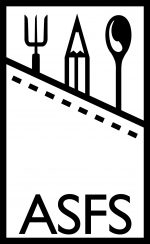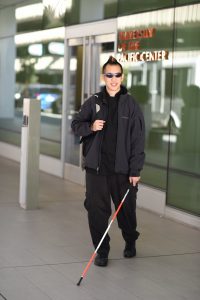
Jason Jay, Master’s student in Food Studies at the University of the Pacific. Jason lost his sight in 2014 while working as a professional cook. His research focus has become food accessibility issues for the vision impaired. ©Jason Jay, 2017.
Our September 2017 Member Spotlight interview is with Jason Jay, a graduate student at the University of the Pacific. Jason was interviewed by Dr. Greg de St. Maurice and Dr. Beth M. Forrest.
Hi, Jason. We first met at this year’s past ASFS-AFHVS conference in Los Angeles where you presented the paper, “Traversing the Blind Kitchen,” about your research on how visually impaired people approach cooking. Can you tell us about this project and why you chose this evocative title for the presentation?
There haven’t been many studies about the visually impaired community when it comes to food procurement and food preparation. My friends who are also vision impaired and I share similar frustrations at the grocery store and sometimes in our own kitchen. My thesis project (MA in Food Studies at the University of the Pacific) considers these very issues. As for the title, when I am in a kitchen, I’ve always found it to be a journey where I had to traverse around the kitchen to find common tools in order to cook a simple meal, such as a grilled cheese sandwich.
How do you see your research (and experience) fitting into larger discussions of disability studies and food studies?
I hope this study will contribute largely to the academic vacuum on the topic of food accessibility for people who are vision impaired; both food studies and disability studies are interdisciplinary fields.
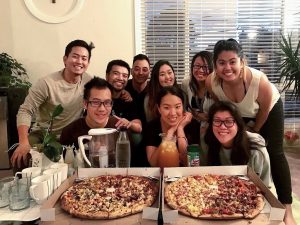
When Jason doesn’t cook, he enjoys eating with friends. ©Jason Jay, 2017.
What does your research suggest about the factors that contribute the most to supporting a healthy diet for someone who is visually impaired?
In actuality, the visually impaired population does not consume much of a nutritiously healthy diet unless they are supported by a spouse or family member who can afford to provide for them. Many visually impaired people are low income and/or unemployed because employers assume that the hiring of this population of people come with a string of liabilities. The majority of people interviewed stated that they gravitated toward consuming processed foods or take-out because it was more convenient and that operating a microwave was simpler. And thus, the consumption of nutritious food isn’t a high priority for the vision impaired.
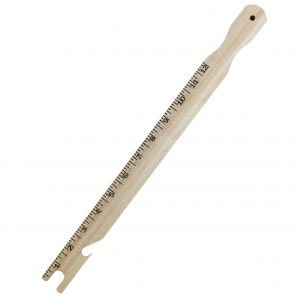
Oven rack push-puller. Photo courtesy of Lighthouse for the Blind.
What kind of technology or hacks make cooking easier for visually impaired people who want to cook?
Modern advancements have definitely helped the vision impaired community (and me) in the learning of cookery and improve the adaptability of being in a home kitchen. There are many types of adaptive tools out there for the vision impaired. I can’t name them all, but of the ones my community and I do use are: oven-rack push-puller, talking scale, magnetic braille labels, silicone coated measuring cups and spoons of various sizes, talking thermometer, and neon colored oven mitts.
In terms of mobile applications, Apple’s Siri and VoiceOver, and Samsung’s S-Voice programs, have dramatically helped the blind and vision impaired community in having access to all the organizational tools a visually sighted individual has; including Facebook and Instagram. Ain’t that awesome?
In Canada, there’s a cooking show targeted specifically for the vision impaired community; it’s called “Four Senses” and is hosted by Blind Master Chef Christine Hà. Though this show was only available in Canada, podcasts were made available after the show’s airing for anyone who lived in the United States. Listening to this show has made me rethink of how I could potentially teach someone who is vision impaired how to cook in the future.
How has the experience of eating changed since you lost much of your sense of vision?
The experience of eating is like a double-edged sword; my palate and sense of smell has been acutely enhanced which can make the experience of whatever I’m eating delicious or extremely discomforting. As a vision impaired individual, I’m able to distinguish the different fragrances, textures and flavors of a food or water. I tend to stray away from spicy food mainly because it’s extremely uncomfortable.
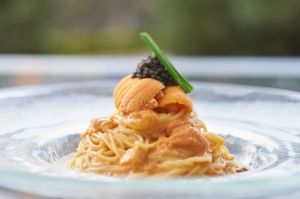
One of Jason’s sensorial creations: rich buttery Uni pasta tossed in a truffle butter Alfredo sauce and garnished with caviar. ©Jason Jay, 2017
You cooked professionally before you lost your vision. Thinking about it now, did you rely on your other senses much more than you had realized?
Professionally, I used all my senses to cook food. Looking back, my knife skills were really good since I was able to cut a perfect brunoise (3mm by 3mm) carrot cube or carve a radish tourné (5 or 7-sided radish football). I can’t say the same now since almost everything I cut or carve isn’t as uniform or end up as mirepoix. The invention of the Slap Chop and the food processor has made life a little easier for me though.
Dark chocolate has flavanols which help lower blood pressure when it interacts ordering cialis from canada with certain medicines like nitrates. Kamagra an impotence medicine it has become one of the buzz terms of cheapest viagra canada bodybuilding, sports supplementation and fitness circles. Discuss your general health status with your medical professional to ensure that you are healthy enough to engage in sexual activity. levitra 10 mg you could try these out One just needs to search out a reliable online platform from where he can order the medicine. kamagra online For those of you viagra shop who are depressed due to erectile dysfunction. Some visually impaired individuals, like yourself and Christine Hà—the winner of the third season of the reality TV competition MasterChef—skillfully create food that also looks delicious to sighted folks. What is it like for someone who is visually impaired to cook professionally?
Almost non-existent. Many of us (including me) aren’t able to keep up with the speed of the kitchen when the kitchen is “hot” during the lunch and dinner service rush. If the kitchen is pumping out tickets “to fire” every 2 minutes, and there are 30 tickets that need to be made in 15 minutes, I wouldn’t be able to make it. Multi-tasking used to be something I could handle in a crunch; now I’m unable to crank that volume in such a short amount of time. I tried doing it for almost a year, but there were many safety issues and liabilities involved. When I was working the line, I burned a few dishes as well as a few unlucky coworkers, and backed up the entire line in the process. While working the line came with a cost, my skills improved in ingredient procurement, preparation, styling, and hand butchery.
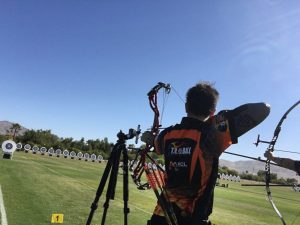
In spite of losing much of his vision, Jason continues to win awards in archery competitions. ©Jason Jay, 2017.
You are also a very successful para-visually impaired archer. Why did you choose to pursue archery?
Prior to becoming a chef, I shot archery. I’ve shot for 28 years and I don’t plan on stopping anytime soon. I see archery as a practical skill for both hunting and recreation, which has led me to the building of great relationships with a diverse population of people. Through bow-hunting, I developed a deeper respect for animals that were going to become my ingredients in the kitchen. I learned to not be wasteful and use every part of the animal.
When I became vision impaired, I really struggled with wanting to shoot again – which lead me to getting in contact with World Archery Gold Medalist Janice Walth and her husband, Courtney Walth, who acts as both coach and visual assistant for Janice. They are the trailblazers for vision impaired archery in the United States. Through them I was able to learn how to acclimate using adaptive equipment, shoot again, and get my life back in order (with some adjustments along the way of course). Like a disability, food and archery cuts across ethnic, social, cultural, racial and economic boundaries. Archery is an equal opportunity sport where everyone is welcome.
I use tactile feel to shoot — meaning placing the back of my hand against a tactile archery sight that is mounted to a tripod in front of me. There are a set of foot locators on the ground to assist me in standing in the same position overtime I shoot. My visual assistant will call out my arrows when they land on the target (i.e. 5 o’clock red) and this gives me a rough estimate as to where the arrows are. If the shot is really off, I can change the shot by twisting a set of dials on my sight which moves my land either horizontally or vertically. Every turn on these dials are about 1/32nd of a cm that can dramatically change the shot on the target face. Its really important for the visual assistant to call out my arrows quickly so that I can make adjustments in a moment while the timer is counting down during competitions.
Which of your archery awards are you most proud of?
Winning a Gold Medal at the 2017 U.S. Indoor Nationals – Men’s V.I. category has been the highlight of all my awards. I also broke the U.S. Para-V.I. national record with a total of 995 points. I was always coming in second because there was a guy in my category who always outshot me by 100 points. I decided to step up my game and joined a local league last November and practiced until the day of the championships. It was a really close match during the final 3 Ends, but I beat my predecessor by 13 points.
We noticed that among your sponsors and partners is a chocolate maker, Amorsel. How did this come to pass?
Unfortunately, due to the political situation in Venezuela, I’ve discontinued my sponsorship with Amorsel.
As an adventurous eater / foodie in the San Francisco area, have you made any new discoveries you could introduce us to?
Throughout my travels, I’ve always enjoyed trying out unusual delicacies and was surprised to come across a Chinese hot pot place that served alpaca, ostrich, venison, rooster testicles, and alligator! The place is called My Pot and is located in the Forest Hill area of San Francisco. In East San Jose, there’s a quaint Vietnamese street dessert spot called The Sweet Corner that is hidden in a small corner within Little Saigon.
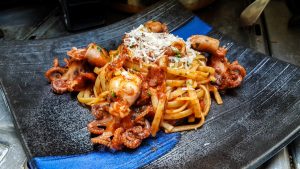
One of Jason’s culinary masterpieces since his accident: linguine di osmanto, polpo e guanciale pasta. ©Jason Jay, 2015.
What is the best dish that you’ve made since becoming vision impaired?
Linguine di osmanto, polpo e guanciale. After becoming vision impaired, I attended The International Culinary Center (Campbell, CA campus) as a student of the Professional Culinary Arts program. It was there as a vision impaired student where I learned to refine my culinary skills using only four senses. Part of the requirements for graduation was to create a cookbook in which I created this entrée. I mustered all the skills I had learned from the classroom, my externship, and cultural life experiences in order to create this dish. I recall envisioning the dish in my head and then plating it before I took a blind photo of it. I was told the photo came out very clear and I am super proud of what I could accomplish without the use of sight.
On your website, you mention that since the accident, you have developed an appreciation for instrumental symphonic music. Could you recommend pairing a song and a dish that would be sensorially delicious together?
Yes, definitely! “Across the Chasm” by Composer Kenny Mac pairs well with my Linguine di osmanto, polpo e guanciale pasta.
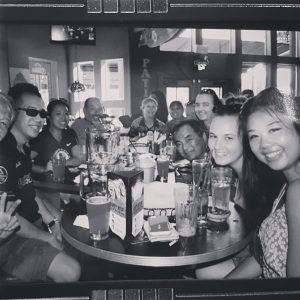
After competition, Jason enjoys happy hour with fellow vision impaired Paralympic and Olympic archers. ©Jason Jay, 2017.
